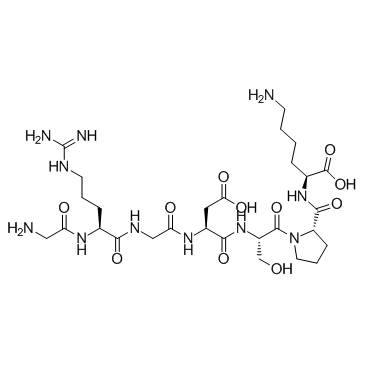H-Gly-Arg-Gly-Asp-Ser-Pro-Lys-OH acetate salt

H-Gly-Arg-Gly-Asp-Ser-Pro-Lys-OH acetate salt structure
|
Common Name | H-Gly-Arg-Gly-Asp-Ser-Pro-Lys-OH acetate salt | ||
|---|---|---|---|---|
| CAS Number | 111119-28-9 | Molecular Weight | 715.75600 | |
| Density | 1.59 g/cm3 | Boiling Point | N/A | |
| Molecular Formula | C28H49N11O11 | Melting Point | N/A | |
| MSDS | USA | Flash Point | N/A | |
|
The hemodynamically-regulated vascular microenvironment promotes migration of the steroidogenic tissue during its interaction with chromaffin cells in the zebrafish embryo.
PLoS ONE 9(9) , e107997, (2014) While the endothelium-organ interaction is critical for regulating cellular behaviors during development and disease, the role of blood flow in these processes is only partially understood. The dorsal aorta performs paracrine functions for the timely migratio... |
|
|
Molecular interplay between endostatin, integrins, and heparan sulfate.
J. Bacteriol. 284 , 22029-40, (2009) Endostatin is an endogenous inhibitor of angiogenesis. Although several endothelial cell surface molecules have been reported to interact with endostatin, its molecular mechanism of action is not fully elucidated. We used surface plasmon resonance assays to c... |
|
|
Inhibition of IL-8-mediated MAPK activation in human neutrophils by beta1 integrin ligands.
Inflammation 26(2) , 83-8, (2002) Chemokine and integrin receptors must work in concert when circulating leukocytes mobilize toward a site of tissue inflammation or infection. In a previous study, we reported that ligation of the alpha5beta1 integrin with a 120-kDa cell-binding fibronectin fr... |
|
|
Flt23k nanoparticles offer additive benefit in graft survival and anti-angiogenic effects when combined with triamcinolone.
Invest. Ophthalmol. Vis. Sci. 53(4) , 2328-36, (2012) To determine if nanoparticles delivering plasmids expressing Flt23k (an anti-VEGF intraceptor) can enhance murine cornea transplant survival and whether their effect is synergistic with steroid therapy.Biodegradable PLGA Flt23k loaded or blank nanoparticles w... |
|
|
Dynamic cell adhesion and migration on nanoscale grooved substrates.
Eur. Cell. Mater. 23 , 182-93; discussion 193-4, (2012) Organised nanotopography mimicking the natural extracellular matrix can be used to control morphology, cell motility, and differentiation. However, it is still unknown how specific cell types react with specific patterns. Both initial adhesion and preferentia... |
|
|
Measuring cell adhesion forces of primary gastrulating cells from zebrafish using atomic force microscopy.
J. Cell Sci. 118(Pt 18) , 4199-206, (2005) During vertebrate gastrulation, progenitor cells of different germ layers acquire specific adhesive properties that contribute to germ layer formation and separation. Wnt signals have been suggested to function in this process by modulating the different leve... |
|
|
Functional effects of transforming growth factor beta on adhesive properties of porcine trophectoderm.
Endocrinology 146(9) , 3933-42, (2005) In pigs, expression and amounts of biologically active TGFbetas at the conceptus-maternal interface increase significantly as conceptuses elongate and begin the implantation process. Before their activation, secreted TGFbetas are noncovalently associated with... |
|
|
Cooperativity in adhesion cluster formation during initial cell adhesion.
Biophys. J. 95 , 5424-31, (2008) We have studied the initial phase of cell adhesion as a function of the lateral organization of individual integrin molecules with single-cell force microscopy. Nanostructures, consisting of hexagonally ordered gold dots, were prepared with diblock-copolymer ... |
|
|
Synthetic peptide containing Arg-Gly-Asp inhibits bone formation and resorption in a mineralizing organ culture system of fetal rat parietal bones.
J. Bone Miner Res. 9(2) , 193-201, (1994) The role of integrins, cell surface receptors involved in cell adhesion to the matrix, was studied in a mineralizing organ culture system. Integrin-mediated cell attachment to matrix proteins has been shown to depend partially on the amino acid sequence Arg-G... |
|
|
Bases in 16S rRNA important for subunit association, tRNA binding, and translocation.
Biochemistry 48 , 6772-82, (2009) Ribosomes are the cellular machinery responsible for protein synthesis. A well-orchestrated step in the elongation cycle of protein synthesis is the precise translocation of the tRNA-mRNA complex within the ribosome. Here we report the application of a new in... |